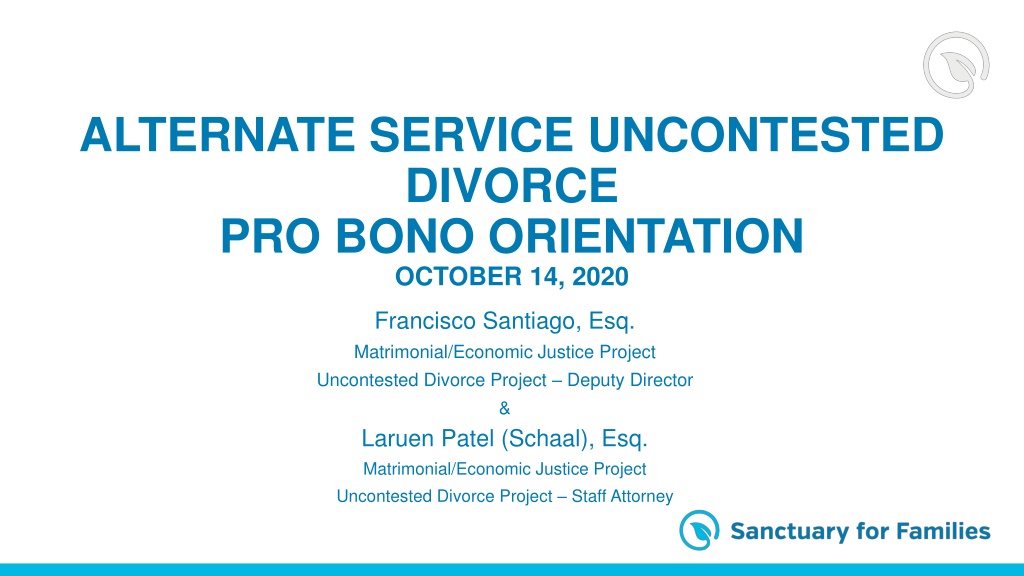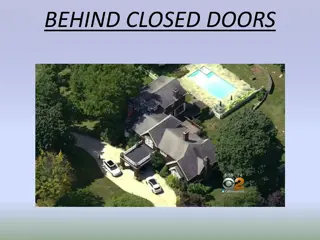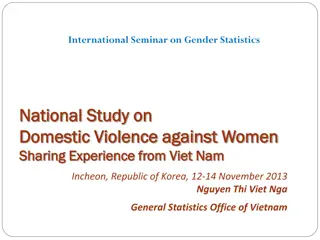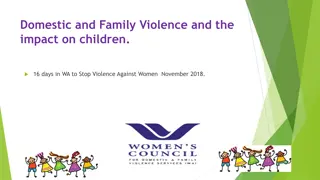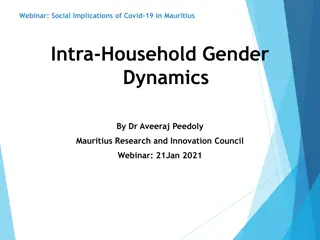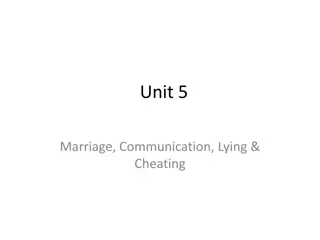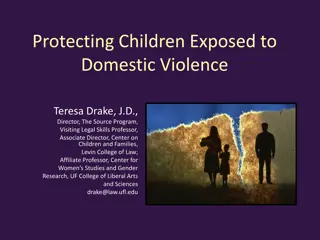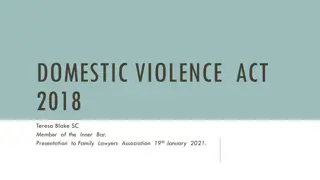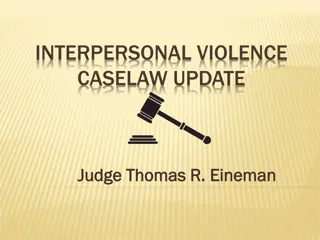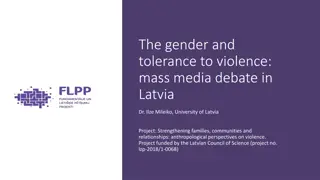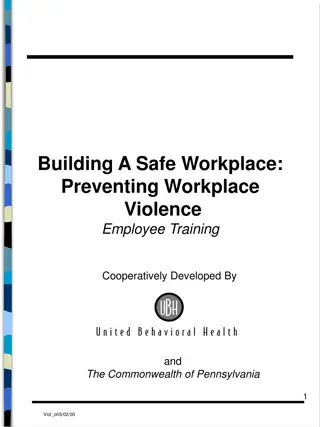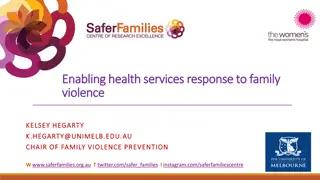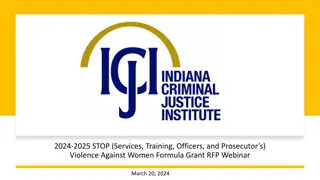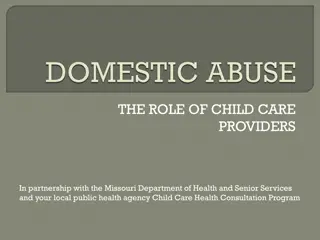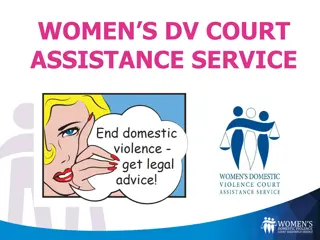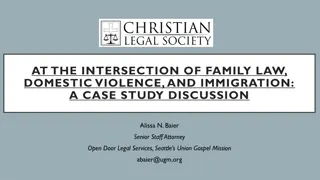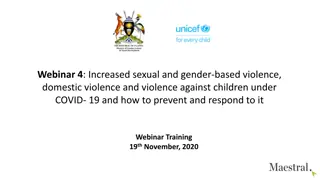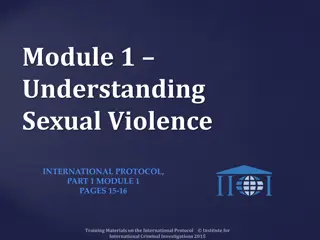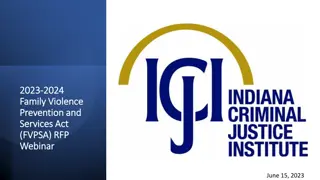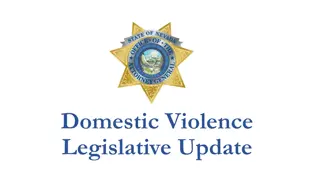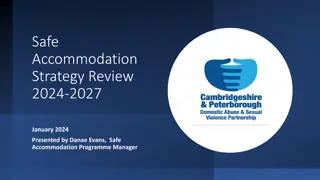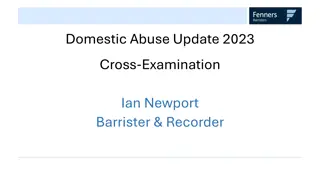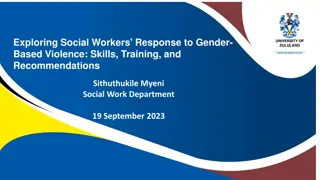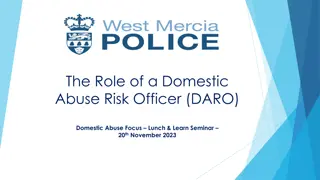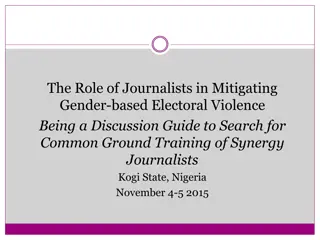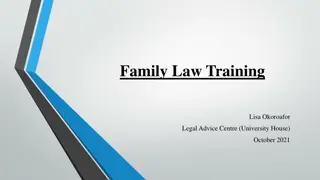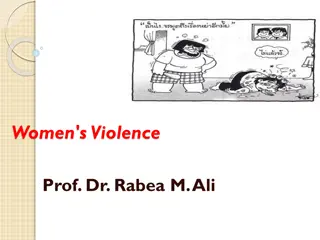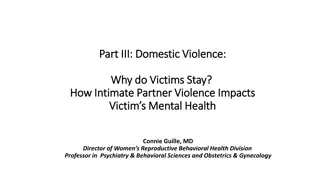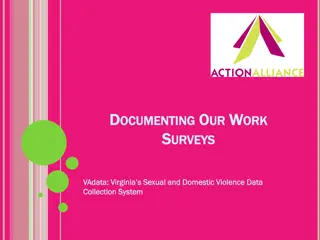Understanding and Addressing Domestic Violence: Important Information and Resources
Learn about domestic violence, its impact, signs of abuse, common obstacles survivors face, and resources available for support and assistance in New York. Gain insights into the dynamics of domestic violence, legal aspects of divorce, and how to access pro bono services. Discover the crucial role of organizations like Sanctuary for Families in combating gender violence.
Download Presentation

Please find below an Image/Link to download the presentation.
The content on the website is provided AS IS for your information and personal use only. It may not be sold, licensed, or shared on other websites without obtaining consent from the author. Download presentation by click this link. If you encounter any issues during the download, it is possible that the publisher has removed the file from their server.
E N D
Presentation Transcript
ALTERNATE SERVICE UNCONTESTED DIVORCE PRO BONO ORIENTATION OCTOBER 14, 2020 Francisco Santiago, Esq. Matrimonial/Economic Justice Project Uncontested Divorce Project Deputy Director & Laruen Patel (Schaal), Esq. Matrimonial/Economic Justice Project Uncontested Divorce Project Staff Attorney
GOALS OF THE ORIENTATION UNDERSTAND DYNAMIC OF DV AND NEEDS OF SURVIVORS UNDERSTAND BASICS OF NEW YORK STATE DIVORCE OBTAIN KNOW-HOWS TO HANDLE A DIVORCE BY ALTERNATE SERVICE. Q & A
SANCTUARY FOR FAMILIES Sanctuary for Families is New York's leading service provider and advocate for survivors of domestic violence, sex trafficking, and related forms of gender violence. OUR MISSION: Sanctuary for Families is dedicated to the safety, healing and self-determination of victims of domestic violence and related forms of gender violence. Through comprehensive services for our clients and their children, and through outreach, education and advocacy, we strive to create a world in which freedom from gender violence is a basic human right.
WHAT IS DOMESTIC VIOLENCE? a pattern of gender-based intimate partner, dating, or family violence with a central dynamic of power and control. Intended to harm the physical and/or mental well-being of the victim and can be psychological, physical, economic or sexual in nature. rarely an isolated incident it is a pattern of coercive behavior intended to exert control and domination by the offender over the victim. usually escalate in frequency and severity.. harms everyone in a family, a household, a neighborhood, a community and our society as a whole.
SIGNS OF ABUSE PHYSICAL ABUSE PSYCHOLOGICAL ABUSE SEXUAL ABUSE ECONOMIC ABUSE TECHNOLOGICAL ABUSE LEGAL ABUSE
COMMON OBSTACLES LANGUAGE BARRIERS LACK OF COMMUNITY/FAMILY SUPPORT; FEAR OF EXCOMMUNICATION TOLERANCE OF DUTY-RIDDEN ABUSE FEAR OF DEPORTATION DEPENDENCE ON IMMIGRATION SPONSORSHIP FEAR OF LOSING CHILDREN AND/OR LOSING SPOUSE STIGMA OF DIVORCE
COMMON OBSTACLES NEGATIVE EXPERIENCES WITH LAW ENFORCEMENT/JUSTICE SYSTEM LACK OF TRUST IN, OR MISUNDERSTANDING OF THE LEGAL SYSTEM ECONOMIC DEPENDENCE LOCALLY AND ABROAD RELIGIOUS BELIEFS ISOLATION FROM SOCIAL/LEGAL NETWORKS
INTERVENTION NEEDED ON MANY FRONTS Obtaining Order of Protection- civil and/or criminal Litigate custody, visitation, spousal support, child support, and/or child abuse/neglect proceedings Getting public benefits Convincing law enforcement to take prosecution of the batterer seriously Immigration remedies Divorce Defend oneself against criminal charges and/or simultaneous cross OP case
AND MUCH MORE Safety Privacy Shelter/Housing Economic Counseling/therapy/psychiatric help Education Parenting/Child care Medical
WHATS A DIVORCE? A legal action to end or dissolve the marriage Legal separation Annulment
MUST ESTABLISH RESIDENCY DRL230 The parties were married in the state and either party is a resident thereof when the action is commenced and has been a resident for a continuous period of one year immediately preceding filing; OR The parties have resided in this state as husband and wife and either party is a resident thereof when the action is commenced and has been a resident for a continuous period of one year immediately preceding; OR The cause occurred in the state and either party has been a resident thereof for a continuous period of one year immediately preceding the commencement of the action (not available in DRL 170 (7) cases -Irretrievably Broken Relationship for 6 months - filed in NY County; see Stancil v. Stancil, 47 Misc.3d 873,[February 17, 2015]); OR The cause occurred in the state and both parties are residents thereof at the time of the commencement of the action; OR Either party has been a resident of the state for a continuous period of at least two years immediately preceding the commencement of the action.
MUST ESTABLISH GROUNDS - DRL170 Cruel and inhuman treatment; Abandonment; Imprisonment for 3 consecutive years during the marriage; Adultery; Living separate and apart pursuant to a separation judgment or decree; Living separate and apart pursuant to a separation agreement; The irretrievable breakdown in the marital relationship ( no fault ).
ANCILLARY ISSUES The Court will not grant a Judgment of Divorce unless all the issues in the marriage are dealt with and resolved: Custody and visitation if the parties have any child under 18; Child support if the parties have any child under 21; Maintenance (formerly known as alimony); If the parties have marital assets and/or debts, the issue of equitable distribution of marital assets and/or debts must be determined or waived. Expert fees, appraisal fees, etc. Counsel fees Order of protection
CONTESTED OR UNCONTESTED DIVORCE? When both parties agree to get divorced and the only issue is getting divorced (i.e. the grounds are the only issue) When both parties agree on all the issues or have resolved all the issues by having obtained family court order(s) When the Defendant fails to respond, after being served and, and a default judgment of divorce can be issued .then it is probably an uncontested case.
DIVORCE: STEP BY STEP COMMENCEMENT OF THE ACTION PURCHASING AN INDEX NUMBER FILING THE INITIAL PAPERS SERVICE OF PROCESS PERSONAL SERVICE ALTERNATIVE SERVICE DEFENDANT S RESPONSE CONSENT DEFAULT APPEAR : LITIGATION AND/OR NEGOTIATION FOR A SETTLMENT FILING THE FINAL PAPERS JUDGMENT OF DIVORCE NOTICE OF ENTRY
WHAT IS AN ALTERNATE SERVICE DIVORCE? Getting a divorce for some DV survivors seems impossible because the defendant/spouse has disappeared or fled the jurisdiction, often to avoid prosecution for a crime of violence against our client or another family member. An alternate service divorce is an uncontested divorce in which the defendant-spouse cannot be located, and, therefore, personal service of the divorce summons cannot be effectuated. In these circumstances, a court may authorize service by nail and mail; email; messaging apps such as WhatApp/social media such as Facebook; or, by publication, after a motion is made articulating the results of a due diligence search for the defendant-spouse. In some instances, the results of the due diligence search reveal the whereabouts of a missing spouse. Then the case can be handled as an uncontested divorce.
FORMS OF ALTERNATE SERVICE NAIL AND MAIL: CPLR 308(4) EMAIL: CPLR 308(5) MESSAGING APPS SUCH AS WhatsApp, or by social media such as Facebook: CPLR 308(5) Publication: CPLR 315
FOUR STEPS TO ACCOMPLISH Conduct due diligence search Submit the initial papers and a Motion for Alternate Service Effect service by nail and mail; email; messenger apps such as WhatsApp/social media such as Facebook; or by publication Submit the final papers to the court
DUE DILIGENCE SEARCH In order for the court to permit service by alternate service, it must be satisfied that a diligent and reasonable searchhas been made to locate the defendant: U.S. Military (all five branches) United States Postal Service ( USPS ) New York City Board of Elections New York State Department of Motor Vehicles ( DMV ) New York City Telephone Directories Internet Visitation of Spouse s Last Known Address (not by client)
U.S. MILITARY Purpose: to determine if the defendant is currently on active military duty. Methodology: Obtain a Servicemembers Civil Relief Act ( SCRA ) certificate either online or by mail. Completion: upon receipt of the SCRA certificate, which will detail (as of the search date provided) whether the defendant (i) is on active duty, (ii) left active duty within the 367 days preceding, or (iii) was notified of a future call-up. Action The client cannot proceed with service by publication if the SCRA indicates that the defendant is currently on active military duty.
U.S. POSTAL SERVICE Purpose: to determine if the USPS has an address on file for the defendant at which service of process can be made. Methodology: fill out Request for Change of Address or Boxholder Information Needed for Service of Legal Process , mail it to the Postmaster of the city of defendant s last known address with a cover letter. Completion: upon receipt of a returned Service of Legal Process form. Action: if a new address is provided, visitation of said address is required. DO NOT SEND THE CLIENT TO THE ADDRESS TO VERIFY. The result of visitation must be detailed in an affidavit.
BOARD OF EDUCATION Purpose: to determine whether the Board of Elections has an address on file for the defendant at which service of process can be made. Methodology: records must be obtained by written request, either via a citywide search through the Manhattan Borough Office or by making separate written requests to each county office. The written request should include the following information: (i) the defendant s full birth name, (ii) the defendant s full married name, (iii) the defendant s SSN, (iv) the defendant s date of birth, and (v) the defendant s last known address. Completion: upon receipt of five search results, one for each county. Action: if a new address is provided, visitation of said address to determine if the defendant resides there is required. DO NOT SEND THE CLIENT TO THE ADDRESS TO VERIFY. The result of the visitation must be detailed in an affidavit.
DEPARTMENT OF MOTOR VEHICLES Purpose: to determine if the DMV has an address on file for the defendant at which service of process can be made. Methodology: Request a Driving Abstract of the defendant, by filling out and submitting Form MV-15 (Request for DMV Records) by mail, specifically requesting a Driving Abstract. Once completed, the form should be sent to the following address listed in the handout, along with proof of identity and a check or postal money order made out to the Commissioner of Motor Vehicles for $10.00. Completion: upon receipt of a Driving Abstract for the defendant. Action: if a new address is provided, visitation of said address is required. DO NOT SEND THE CLIENT TO THE ADDRESS TO VERIFY. The result of visitation must be detailed in an affidavit.
NYC TELEPHONE DIRECTORIES Purpose: to determine if there are public phone records available for the defendant. Methodology: Search within a physical phone book or online phone directory for any listing of the defendant s full name or last name and first initial. Completion: when a search has been performed in each of the five boroughs. Action: If performed online, search results must be printed. Whether the search is performed online or using an actual phone book, the attorney, or a trusted individual other than the client, must call each number that is found as a result of the searches and personally verify that the person listed at the number is, or is not the defendant. The result of verification must be detailed in an affidavit.
INTERNET SEARCHES Purpose: to determine if there are any other publicly available records of the defendant not captured in the first five due diligence steps. Methodology: Perform an online database search in each of the five boroughsfor the defendant s full name through one of the websites: Intelius, Zaba or Public Background Checks Completion: if any search returns a hit, the report(s) must be purchased. Action: if a new address or new phone number is provided, visitation of said address and verification of the phone number by calling is required. DO NOT SEND THE CLIENT TO THE ADDRESS TO VERIFY, NOR CALL. The result of visitation and phone verification must be detailed in an affidavit.
VISITATION OF DEFENDANTS LAST KNOWN ADD. Purpose: to determine if the defendant still lives at the address last known to your client. Methodology: If you have not already done so, you must visit the defendant s address, as last known by your client unless the USPS due diligence search results specifically state that the defendant does not live at the address last known to your client (note that you must still visit the last known address even if the USPS search comes back with a No forwarding address result). Completion: upon personal verification Action: The result of visitation must be detailed in an affidavit.
COMMENCEMENT OF THE ACTION: INITIAL FILING PURCHASE AN INDEX NUMBER: $210 or a fee waiver MOTION FOR SERVICE BY ALTERNATE SERVICE Proposed Order, Affidavit, Affirmation, Exhibits MOTION TO MAINTAIN PLAINTIFF S ADDRESS CONFIDENTIAL Proposed Order, Affidavit, Affirmation, Exhibits INITIAL PAPERS: Summons with Notice+DRL236 Notice+DRL255 Notice+ Child Support Standards Chart, if any children of the marriage under 21 years of age. RJI and/or RJI addendum (if any children of the marriage under the age of 18). Sworn Statement of Removal of Barriers to Remarriage (if applicable i.e., if a religious marriage).
ALTERNATE SERVICE OTHER THAN PUBLICATION DIVORCE. After the Court grants the Alternate Service Motion for service by Nail and Mail; service shall be effectuated pursuant to CPLR 308(4) - see page 17 of the manual. After the Court grants the Alternate Service Motion and orders service by email; messaging app such as WhatsApp or social media, such as Facebook, service shall be effectuated pursuant to CPLR 308(5) see pages 17-18, in the manual.
PUBLICATION OF NOTICE OF DIVORCE ACTION After the Court grants the Alternate Service Motion and orders service by publication, the attorney can then publish the Notice of the Divorce Action in the newspaper that has been designated by the Court under CPLR 316. Submit to the newspaper all the information designated by the Order of Publication. This information generally includes: Title of action; Order to Serve by Publication granted by the Court; Notice to be Published, which is the sample notice of publication that has been submitted to the Court when filing the motion; and Copy of the Poor Person Certificate (if applicable) to obtain a discounted publication rate if possible.
NEW YORK LAW JOURNAL Most of Sanctuary s publication divorce clients effect service through publication in the New York Law Journal ( NYLJ ). The NYLJ will waive the publication fees for indigent litigants with a fee waiver form supplied by Sanctuary for Families.
SERVICE BY PUBLICATION EFFECTUATED The newspaper should publish the Notice to be Published once a week for three consecutive weeks. Once publication has occurred for three consecutive weeks, obtain a signed and notarized statement from a clerk at the newspaper indicating that the advertisement has been published for three consecutive weeks. Service is deemed completed, the day of the third of the three consecutive weekly publications.
FINAL PAPERS Note of Issue (3 copies). Part 130 certification by an attorney. Affirmation of Regularity. Plaintiff s Affidavit. If there are any children under 21, Child Support Order or a Child Support Worksheet. Proposed Findings of Fact and Conclusions of Law. Proposed Judgment of Divorce. Certificate of Dissolution of Marriage (Form DOH-2168.); Support Collection Unit Information Sheet or State Case Registry Form (if applicable). Child Support Summary Form (Form UCS-111, if applicable). An affidavit by Plaintiff to explain why Defendant s SSN is unknown (if applicable). A self-addressed postcard for the Court to notify the attorney regarding the status of the case.
JUDGMENT OF DIVORCE GRANTED Upon receipt of the court s notice by postcard, obtain a certified copy of Judgment of Divorce from the county clerk Serve a Notice of Entry+ Judgment of Divorce upon Defendant at the last known residential address File the Notice of Entry + Affirmation or Affidavit of Service with the clerk of court. Provide the client with a certified copy of Judgment of Divorce + a copy of Notice of Entry and proof of service + a Closing Letter. Date of Divorce is the date when the Judgment entered, not signed.
Q&A Will the pro bono attorney be able to refer the client back to Sanctuary for other legal needs or non-legal needs? Certainly. Sanctuary provides holistic services to the survivors gender based violence. Please contact Sanctuary so we could address the needs and make appropriate referrals, either to our in-house resource or to other providers. Where can the pro bono attorney find the manual and the samples needed? We have created an online platform where we house the training manual and all samples that you may need. Please visit www.sffmat-ejp.weebly.com
CONTACT INFORMATION Francisco Santiago, Esq. Matrimonial/Economic Justice Project Deputy Director Fsantiago@sffny.org (212) 349-6009 x 315 Lauren Patel (Schaal), Esq. Matrimonial/Economic Justice Staff Attorney Lschaal@sffny.org (212) 349-6009, ext. 346 Nicole Fidler, Esq. Director of Pro Bono Program Nfidler@sffny.org (212) 349-6009 x 282
